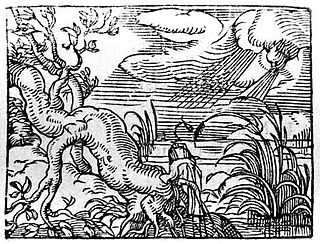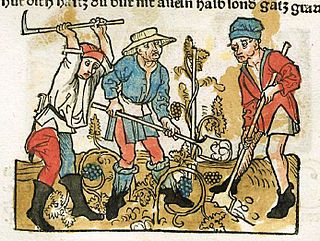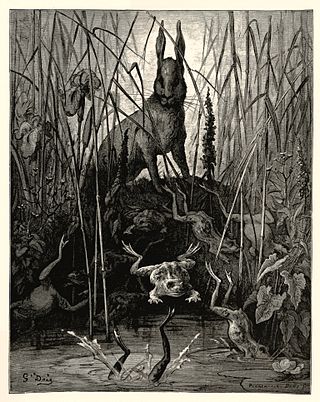
The Satyr and the Traveller (or Peasant) is one of Aesop's Fables and is numbered 35 in the Perry Index. The popular idiom 'to blow hot and cold' is associated with it and the fable is read as a warning against duplicity.

The Satyr and the Traveller (or Peasant) is one of Aesop's Fables and is numbered 35 in the Perry Index. The popular idiom 'to blow hot and cold' is associated with it and the fable is read as a warning against duplicity.
There are Greek versions and a late Latin version of the fable by Avianus. In its usual form, a satyr or faun comes across a traveller wandering in the forest in deep winter. Taking pity on him, the satyr invites him home. When the man blows on his fingers, the satyr asks him what he is doing and is impressed when told that he can warm them that way. But when the man blows on his soup and tells the satyr that this is to cool it, the honest woodland creature is appalled at such double dealing and drives the traveller from his cave. There is an alternative version in which a friendship between the two is ended by this behaviour.
The idiom 'to blow hot and cold (with the same breath)' to which the fable alludes was recorded as Ex eodem ore calidum et frigidum efflare by Erasmus in his Adagia (730, 1.8.30). [1] Its meaning was further defined by the emblem books of the Renaissance, particularly those that focused on fables as providing lessons for moral conduct. While Hieronymus Osius tells the tale of the traveller and draws the moral that one should avoid those who are inconstant, [2] Gabriele Faerno puts it in the context of friendship and counsels that this should be avoided with the 'double-tongued' (bilingues). [3] In this he is followed by Giovanni Maria Verdizotti, [4] Marcus Gheeraerts the Elder [5] and Geoffrey Whitney. [6]

However, in Francis Barlow's edition of the fables (1687), the Latin text warns against those whose heart and tongue do not accord, while Aphra Behn comments in English verse that "The sycophant with the same breath can praise/ Each faction and what's uppermost obeys", [7] following John Ogilby's slightly earlier example of giving the story a political interpretation. But there is more nuance in Ogilby's narrative. He places the 'honest' race of satyrs among the infernal species, a point emphasised by the accompanying Wenceslas Hollar print that shows the battle in heaven and the fall of Lucifer as taking place outside the mouth of the cave in which the traveller is blowing on his broth. In this way the fable's interpretation is subtly redirected and its condemnation of the double-tongued turns into a sly stab at the Puritan vocabulary by the time the moral is reached:
Fiends and Saints convertible be, for where
We spy a Devil, some say a Saint goes there. [8]
The fable was included as Le satyre et le passant among the fables of Jean de la Fontaine (V.7) [9] but with no alteration of moral. However, this version too was to be reinterpreted in a political sense in the 19th century. In the course of his very free version, John Matthews expanded the text to comment on the 1819 election in Westminster and advise the voters to adopt the satyr's view of blowing hot and cold. [10] In France the satirical cartoonist J.J. Grandville also updated the meaning by showing a group of loungers reading and commenting on the newspapers in a public park next to a statue illustrating the fable (see in Gallery 4 below).
The Age of Enlightenment had intervened and prominent thinkers had then attacked the logic of this fable in particular. In the article on "Fable" in his Dictionnaire Philosophique (1764), Voltaire remarked that the man was quite right in his method of warming his fingers and cooling his soup, and the satyr was a fool to take exception. [11] The German philosopher Gotthold Ephraim Lessing asserts in one of his essays on fables that its fault 'lies not in the inaccuracy of the allegory, but that it is an allegory only', perhaps reaching towards the conclusion that the fable had been badly framed around an already existing proverb. 'The man ought really to have acted contradictorily; but in this fable he is only supposed to have done so.' [12] By using the fable to focus on political behaviour, therefore, the writers and artists give it a justification not inherent within its narrative.
During the 18th century new versions of fables were written to fit popular airs. "The Satyr and the Traveller" was set to the tune "I'll tell thee Dick where I have been" and was collected among 470 other songs in the English compilation titled The Lark (London 1740). [13] But the poem itself, consisting of four six-line stanzas beginning "To his poor Cell a Satyr led/ A Traveller with Cold half dead", was originally written by Tom Brown near the turn of that century and appeared in the posthumous collection of his works. [14] Thereafter the poem was reprinted in several other compilations for well over a century. It was later joined by a different musical version of the fable beginning "When chilling wind and snow clad tree/ Made Robin seek the Cottage door". [15]
The same process of fitting new words to old tunes was also happening in France during the 18th century. There the most ambitious compilation was the Receuil de fables choisies dans le goût de M. de la Fontaine sur de petits airs et vaudevilles connus (Imitations of La Fontaine's fables set to popular airs, Paris 1746). In it is to be found the retitled "Le Satire et son Hôte", also comprising four six-line stanzas, subtitled "Duplicity" and sung to the air "Le fameux Diogene". [16] In 1861 La Fontaine's own words were set to music by Pauline Thys as the second piece in her Six Fables de La Fontaine (1861), [17] as well as by Théodore Ymbert in the previous year. [18] Théophile Sourilas (1859-1907) made his setting for three voices in 1900. [19]

For a variety of reasons the fable of "The Satyr and the Peasant" in particular became one of the most popular genre subjects in Europe and by some artists was painted in many versions. It was particularly popular in the Netherlands, where it brought together the contemporary taste for Classical mythology and a local liking for peasant subjects. At the start of the 17th century the poet Joost van den Vondel published his popular collection based on Marcus Gheeraerts' prints, Vorstelijke Warande der Dieren (Princely pleasure-ground of beasts, 1617), in which the poem Satyr en Boer appears. [20] This seems to have appealed to the imagination of the young Jacob Jordaens, who went on to produce some dozen versions of the subject and did more than any other painter to popularise it. [21] He was followed in his native Antwerp by others such as Willem van Herp, David Ryckaert the younger and Jan Cossiers, while in the Dutch Republic it was taken up by the group of Rembrandt's pupils and followers, Gerbrand van den Eeckhout, Barent Fabritius and Claes Corneliszoon Moeyaert, as well as by genre painters like Benjamin Gerritsz Cuyp and Jan Steen.
Although the Italians Faerno and Verdizotti were before them in literary treatments, the subject was applied to large-scale oil paintings by German and Netherlandish artists working in Italy like Johann Liss and Matthias Stom, and later taken up by Sebastiano Ricci and Gaspare Diziani. Since the southern Netherlands were then under Spanish rule and paintings from there found their way to Spain, the young Diego Velázquez also made the fable one of his subjects. [22] French treatments were largely confined to La Fontaine's fable and include a work by Pierre Marie Gault de St Germain, painted for King Stanislas of Poland and exhibited in the 1790 Salon, [23] and one by Jules Joseph Meynier (1826–1903), exhibited at the Salon of 1872 and purchased by the state. [24] There was also an English treatment by E.H.Wehnert shown in 1833 at the exhibition of the New Society of Painters in Watercolours. [25]
The scene of the fable depends on the version followed. The traveller is invited into the satyr's home, which is often shown as a cave – and is specified as such in La Fontaine's version. In early illustrations the guest may be shown, illogically, as being entertained outside the dwelling, rather than sheltering within it. During the 17th century, peasant interiors served as an opportunity to crowd the picture with small details and fill the space with animals and (where the theme is the friendship between satyr and man) members of the man's family. Alternatively, members of the satyr's family are shown where La Fontaine's fable is followed, culminating in the charming little satyrs who crowd round the traveller in Gustave Doré's illustration. The Netherlands painters also show a particular interest in light, especially those near in time to Caravaggio and the effects he achieved. Most often the light enters from the door, although in some paintings the source is more ambiguous and creates a dramatic effect as it picks out a group either at the centre or to one side of the painting. Where the main interest is in the moral of the fable, the picture space is unencumbered and serves only as an accompaniment to the story. But as interest shifts away from the story as such, detail and composition become the main focus and the fable is relegated to being the excuse for an exercise of the painterly art.

Aesop's Fables, or the Aesopica, is a collection of fables credited to Aesop, a slave and storyteller who lived in ancient Greece between 620 and 564 BCE. Of varied and unclear origins, the stories associated with his name have descended to modern times through a number of sources and continue to be reinterpreted in different verbal registers and in popular as well as artistic media.

The Ant and the Grasshopper, alternatively titled The Grasshopper and the Ant, is one of Aesop's Fables, numbered 373 in the Perry Index. The fable describes how a hungry grasshopper begs for food from an ant when winter comes and is refused. The situation sums up moral lessons about the virtues of hard work and planning for the future.
The lion's share is an idiomatic expression which now refers to the major share of something. The phrase derives from the plot of a number of fables ascribed to Aesop and is used here as their generic title. There are two main types of story, which exist in several different versions. Other fables exist in the East that feature division of prey in such a way that the divider gains the greater part - or even the whole. In English the phrase used in the sense of nearly all only appeared at the end of the 18th century; the French equivalent, le partage du lion, is recorded from the start of that century, following La Fontaine's version of the fable.

The Monkey and the Cat is best known as a fable adapted by Jean de La Fontaine under the title Le Singe et le Chat that appeared in the second collection of his Fables in 1679 (IX.17). It is the source of popular idioms in both English and French, with the general meaning of being the dupe of another.

The Dog and Its Reflection is one of Aesop's Fables and is numbered 133 in the Perry Index. The Greek language original was retold in Latin and in this way was spread across Europe, teaching the lesson to be contented with what one has and not to relinquish substance for shadow. There also exist Indian variants of the story. The morals at the end of the fable have provided both English and French with proverbs and the story has been applied to a variety of social situations.

The Oak and the Reed is one of Aesop's Fables and is numbered 70 in the Perry Index. It appears in many versions: in some it is with many reeds that the oak converses and in a late rewritten version it disputes with a willow.

The miller, his son and the donkey is a widely dispersed fable, number 721 in the Perry Index and number 1215 in the Aarne–Thompson classification systems of folklore narratives. Though it may have ancient analogues, the earliest extant version is in the work of the 13th-century Arab writer Ibn Said. There are many eastern versions of the tale and in Europe it was included in a number of Mediaeval collections. Since then it has been frequently included in collections of Aesop's fables as well as the influential Fables of Jean de la Fontaine.
The drowned woman and her husband is a story found in Mediaeval jest-books that entered the fable tradition in the 16th century. It was occasionally included in collections of Aesop's Fables but never became established as such and has no number in the Perry Index. Folk variants in which a contrary wife is sought upstream by her husband after she drowns are catalogued under the Aarne-Thompson classification system as type 1365A.
The Crow or Raven and the Snake or Serpent is one of Aesop's Fables and numbered 128 in the Perry Index. Alternative Greek versions exist and two of these were adopted during the European Renaissance. The fable is not to be confused with the story of this title in the Panchatantra, which is completely different.

The Dog and the Wolf is one of Aesop's Fables, numbered 346 in the Perry Index. It has been popular since antiquity as an object lesson of how freedom should not be exchanged for comfort or financial gain. An alternative fable with the same moral concerning different animals is less well known.

The Ass and his Masters is a fable that has also gone by the alternative titles The ass and the gardener and Jupiter and the ass. Included among Aesop's Fables, it is numbered 179 in the Perry Index.
The Old Man and Death is one of Aesop's Fables and is numbered 60 in the Perry Index. Because this was one of the comparatively rare fables featuring humans, it was the subject of many paintings, especially in France, where Jean de la Fontaine's adaptation had made it popular.

Hercules and the Wagoner or Hercules and the Carter is a fable credited to Aesop. It is associated with the proverb "God helps those who help themselves", variations on which are found in other ancient Greek authors.

The Ape and the Fox is a fable credited to Aesop and is numbered 81 in the Perry Index. However, the story goes back before Aesop's time and an alternative variant may even be of Asian origin.

The Farmer and his Sons is a story of Greek origin that is included among Aesop's Fables and is listed as 42 in the Perry Index. It illustrates both the value of hard work and the need to temper parental advice with practicality.

Hares are proverbially timid and a number of fables have been based on this behaviour. The best known, often titled "The Hares and the Frogs", appears among Aesop's Fables and is numbered 138 in the Perry Index. As well as having an Asian analogue, there have been variant versions over the centuries.

The classical legend that the swan sings at death was incorporated into one of Aesop's Fables, numbered 399 in the Perry Index. The fable also introduces the proverbial antithesis between the swan and the goose that gave rise to such sayings as ‘Every man thinks his own geese are swans’, in reference to blind partiality, and 'All his swans are turned to geese', referring to a reverse of fortune.

The Eagle and the Fox is a fable of friendship betrayed and avenged. Counted as one of Aesop's Fables, it is numbered 1 in the Perry Index. The central situation concerns an eagle that seizes a fox's cubs and bears them off to feed its young. There are then alternative endings to the story, in one of which the fox exacts restitution, while in the other it gains retribution for its injury.

"The Lion Grown Old" is counted among Aesop's Fables and is numbered 481 in the Perry Index. It is used in illustration of the insults given those who have fallen from power and has a similar moral to the fable of The dogs and the lion's skin. Parallel proverbs of similar meaning were later associated with it.

The Satyr and the Peasant or The Satyr and the Peasant Family is the title commonly given to a number of paintings executed by the Flemish Baroque painter Jacob Jordaens and his workshop based on the fable of the Satyr and the Peasant from Aesop's Fables. Jordaens returned regularly to this subject from his earliest active years until his mature period around 1650. In his treatment of the subject, he combines two of the painting genres in which he excelled: mythological painting and the peasant genre. His various interpretations of the subject and the many repetitions of these works by his workshop and followers popularized the theme which was then taken up by Flemish and Dutch painters such as Jan Cossiers and Jan Steen.
{{cite book}}: |work= ignored (help)